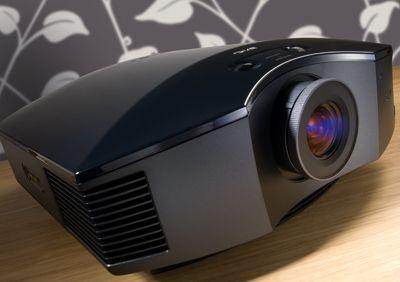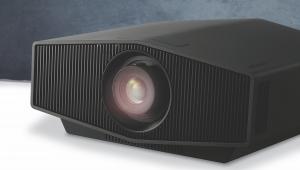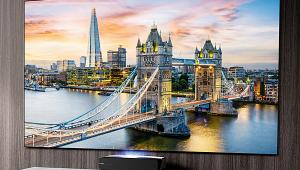Sony VPL-HW30ES review

If I was building a dedicated home cinema tomorrow, I would, without doubt, install a 3D projector. While cynics continue to shrug at the tsunami tide of 3D flatscreen TVs heading our way, and I also have some reservations, I’ve yet to meet anyone who’s walked away from a 3D home projector demo who didn’t have a grin on their face.
After all there’s something completely understandable about the simple proposition of movie- watching in a dark room, with no disturbances. In this context, 3D is a killer addition to the home entertainment experience.
And if I was equipping said picture palace, Sony’s second generation VPL-HW30ES would be on my shortlist. It’s a breathtakingly good projector, blessed with an alluring price tag. By my reckoning, that’s the equivalent of around fifty family visits to the local multiplex (including snacks and beverages). This thing would pay for itself in no time…
Glossy designThe VPL-HW30ES’ design is in line with previous Sony SXRD (Silicon X-tal Reflective Display) projectors. The distinctive curvaceous, glossy lid and side-mounted inputs look suitably swish. My test sample was finished in the standard black, but there’s a new white finish (pictured overleaf) available, too. There’s a broad connection choice of two HDMIs, PC D-Sub, component video, RS232 and Ethernet. Yet one obvious omission is a 12V trigger. Frankly all projectors of this calibre should have this as standard. Used to integrate a projector with an electric screen, this 3.5mm jack can hardly be construed as a luxury. I’m sure I’m not alone at feeling a little miffed by its absence.
There are other marked differences between this model and last year’s VPL-VW90ES, but these seem more justifiable given the cost saving. The motorised lens protector and zoom have gone, along with the ingeniously integrated 3D glasses sync transmitter. Instead, we get a separate transmitter, the TMR-PJ1, which ties to the projector via Cat5 cable. Consequently, you’ll need to give the VPL-HW30ES some thought when it comes to installation, as the transmitter needs to be placed close to the screen, facing the audience.
Thankfully, the imaging engine beneath the lid is just the same; the 240Hz panel delivers superb detail and colour fidelity. New this season is a Dynamic Lamp Control which delivers three times the brightness of last year’s model. This light boost makes a huge difference to 3D performance.
Sony has also refined its 3D projector glasses. First time around, you needed to affix little filters to each lens; this year the new Active Shutter TDG-PJ1 eyewear is good to go straight from the box. They’re also considerably lighter; Sony has reduced their weight by 18g. Even worn over prescription spectacles, they’re manageable. While they have to be manually powered up to sync, they switch-off automatically, preserving juice. The glasses are USB rechargeable – a 30-minute session on the ring main provides around 30 hours of use. Interestingly, the spectacles are not officially included with the projector. Like the transmitter, they’re an optional extra. However, Sony UK concedes that all dealers are likely to bundle goggles and projector together as a package. Do remember to check this when comparing prices from different retailers.
The motorised zoom may be missed, but horizontal and vertical lens shift wheels make for a simple setup. The throw distance is generous enough to achieve an image of 120in from a distance of a little over 13ft. The remote control is also backlit, an eminently sensible provision. The VPL-HW30ES is respectfully quiet. Run the lamp on Low and fan noise drops to a gentle 22dB; this is perfectly acceptable in a cinema environment. Even during quiet scenes I wasn’t really aware of it.
Simply ravishingWhile this projector offers multiple tweaks for colour temperature, gamma and noise reduction, you really don’t need to work too hard to get a great-looking image.
Regardless of your views on 3D, the VPL-HW30ES is a fine 2D projector. It’s capable of deep, convincing blacks with tangible shadow detail. Unlike rival D-ILA technology, SXRD relies on a dynamic iris to deliver deep contrast. Here the Advanced Iris system has a couple of auto modes, which adjust to scene content; sensitivity is variable. I wasn’t particularly aware of the iris opening or closing during my audition. Alternatively, you can manually set and fix it to taste.
The VPL-HW30ES is all about eye candy. Arthouse animation Chico & Rita looks simply ravishing, displaying vibrant reds rather than washed-out oranges. Colours really pop from the screen. There are no fewer than nine picture presets available, including a trio of Cinema modes designed to emulate the characteristics of ‘real film’, ‘digital cinema’ and ‘pro monitors.’ There are also modes dedicated to 3D gaming and still photography. Investigate them at your leisure, because differences can be subtle.
Motion resolution is good, provided you engage Sony’s proprietary fast framerate technology. The VPL-HW30ES offers two MotionFlow processing modes, Low and High. With MotionFlow off, the moving picture resolution of the unit falls from 1080lines to approximately 750 (when motion is locked at 6.5 pixels per frame). The good news is that horizontal panning judder is inherently low.
Switch the Motion Enhancer to Low and definition creeps up to around 950lines. The process creates some slight artefacts around moving objects, but nothing to write home about. I’d regard either setting as fine for watching movies.
Give the High setting a wide berth though, unless you’re watching ice hockey... or maybe curling. The resulting sheen removes all traces of cinematic texture.
In 3D mode, the VPL-HW30ES is nearly as impressive. The 240Hz panel is fast, but there’s still some double imaging visible on traditionally troublesome Blu-ray discs. Thankfully, the quality of 3D authoring is evolving rapidly and as a consequence discs seem less susceptible to crosstalk. Resident Evil: Afterlife and Tangled (an interesting double bill at the best of times) offer stunning depth and clarity. Resident Evil... consistently uses rain and water to emphasise depth, which is far more effective on a large screen than when viewed on 3D TV. The credit sequence in particular is stunning; you really will feel caught in the downpour.
The VPL-HW30ES is equally entertaining when fed by a console. Sony has a small but perfectly formed selection of 3D titles now for the PS3, and they’re quite a hoot in Gigantovision. Fast-moving games are next to impossible to spot crosstalk on, so you can just relax and play.
Perhaps predictably, Sony has also invested this projector with the ability to dimensionalise 2D content, using algorithms borrowed from its Bravia TV line. However, I hereby deem this feature to be pointless and refuse to comment on it further.
Two thumbs upThe Big S has delivered a barnstorming big-screen product with the VPL-HW30ES. Not only is it good enough to convert the fiercest 3D cynics, it’s also a darn fine 2D projector in its own right. While it may not be perfect – the lack of a 12V trigger particularly rankles and I’d rather the transmitter was back integrated with the lens assembly – this remains a compelling argument for bringing big-screen 3D home.
HCC VERDICT
Sony VPL-HW30ES
Price: £3,000 Approx
Highs: Gorgeous 2D performance; deep blacks and excellent colour
Lows: No 12V trigger; minor crosstalk; separate 3D sync transmitter
Performance: 5/5
Design: 4/5
Features: 4/5
Overall: 4/5
Specifications
3D: YES Active shutter
Full HD: YES 1080p/24
Component video: YES one set of inputs
HDMI: YES 2 v1.4
PC input: YES
D-Sub 15 Pin 12V trigger: NO
Resolution: 1920 x 1080
Brightness (claimed): 1,300 ANSI Lumen
Contrast ratio (claimed): 70,000:1
Dimensions: 407 x 179 x 464 mm (w/h/d)
Weight: 10kg
Features: 240Hz SXRD panel; frame sequential/side by side/ top and bottom 3D; 2D-3D conversion; backlit remote control, MotionFlow fast framerate technology; Advanced Iris system; Dynamic Lamp Contro; real /digital cinema/pro monitors Cinema modes; 480/60i, 576/50i, 480/60p, 576/50p, 720/60p, 720/50p, 1080/60i, 1080/50i, 1080/24p; TMR-PJ1 sync emitter and TDG-PJ1 3D-glasses available as an optional extra
 |
Home Cinema Choice #351 is on sale now, featuring: Samsung S95D flagship OLED TV; Ascendo loudspeakers; Pioneer VSA-LX805 AV receiver; UST projector roundup; 2024’s summer movies; Conan 4K; and more
|























































